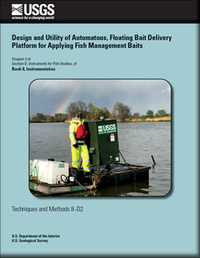Design and Utility of Automatous, Floating Bait Delivery Platform for Applying Fish Management Baits
Links
- Document: Report (1.3 MB pdf) , HTML , XML
- Download citation as: RIS | Dublin Core
Acknowledgments
Funding was provided by the U.S. Geological Survey Ecosystems Mission Area, Biological Threats & Invasive Species Research Program, and the Great Lakes Restoration Initiative (https://www.usgs.gov/special-topics/great-lakes-restoration-initiative).
Abstract
Using manufactured baits to attract fish to passive gear is common practice in fisheries management. The most common method is using hoop nets baited with soybean cakes or waste cheese to increase captures of multiple catfish species; however, these techniques are limited to how often bait is added, the type of bait, gear compatibility, and oversaturation of bait during soak time. The U.S. Geological Survey developed a technique to deliver various types of manufactured, pelleted baits over multiple scenarios and traditional passive gears. A floating platform designed with a dispenser can be constructed easily and allows for the automatic application of varying quantities and sizes of bait. Bait platforms can be modified for use in lakes and rivers where water fluctuations are common. Unlike traditional baiting techniques, these platforms can be positioned over or near any type of gear and release bait as many as nine times daily. Programmed release of bait multiple time a day can be useful to target fish activity during specific hours and can allow for sustained application without bait oversaturation or deterioration from long soak times. This report describes the design of a bait delivery platform developed for deployment in the Sandusky River in Ohio for the removal of Ctenopharyngodon idella (Valenciennes, 1844; grass carp) during 2021 and 2022.
Introduction
Using baits and attractants to aggregate invasive carps in targeted locations to enhance their removal is highly desirable. Traditional use of bait requires daily deployment within a net or trap, which can limit the time the bait is effective at attracting fish because of oversaturation and (or) consumption by initial fish. Baited hoop nets are commonly used to increase catch rates of multiple catfish species by commercial fishers and management biologists. Bodine and others (2013) recommend tandem baited hoop nets as the most efficient method for capturing Ictalurus punctatus (Rafinesque, 1818; channel catfish). Soybean cake and waste cheese are the most common baits traditionally used with hoop nets for capturing channel catfish (Flammang and Schultz, 2007; Bodine and others, 2013). Nets baited with soybean cake have also been determined to increase catch rates of fish species other than catfish (Pierce and others, 1981). The bait effectiveness generally is believed to increase with the number of days the bait is used (Bonneau and Scarnecchia, 2001; Neely and Dumont, 2011; Hundt and others, 2020).
Baits can be used for more than attracting fish for removal. Ghosal and others (2018) used a corn bait for more than 7 days to attract Cyprinus carpio (Linnaeus, 1758; common carp) so the carp could be detected using environmental deoxyribonucleic acid (more commonly known as eDNA) to demonstrate its use as a possible early detection tool. Additional uses of baits include drawing invasive fish to locations where they can be detected or removed using traditional gear and incorporating a chemical to increase selectivity for the control chemical (Mallison and others, 1995; Poole and others, 2018; Hundt and others, 2020). An automatous delivery platform that can apply manufactured baits and attractants has utility in traditional fisheries techniques and invasive pest management strategies.
Here, we describe a platform made from readily available components. The baiting platform could be integrated into existing management strategies for long-term (days or weeks), intermittent bait deployment at minimal cost. These automated bait platforms were field tested with a plant-based bait and pelleted, dried algae attractant as part of the adaptive response plan for Ctenopharyngodon idella (Valenciennes, 1844; grass carp) in the Lake Erie Basin (not shown). Using the baiting platform to deliver bait for fish management may be an efficient and effective way to enhance removal of grass carp. The autonomous design of the baiting platform could also be combined with other fisheries techniques (for example, telemetry and sonar) to allow for long-term (days or weeks) monitoring without daily net sets.
Purpose and Applicability
The purpose of this report is to provide guidance for the construction and use of an automatous bait delivery platform that can be deployed in lakes and large rivers. The platform has been designed for independent use or in combination with different fish collection techniques. Although bait platforms can be modified for specific requirements and local conditions, this report documents guidelines for a field-tested system. Design modifications were made over 2 years of field testing to help construct a safe, reliable platform that can contain enough bait for a month-long deployment and can withstand high water conditions with minimal need for daily monitoring. During the 2 years of deployment on the Sandusky River, Ohio (not shown), platforms withstood river conditions ranging from 0.99 to 390.77 cubic meters per second of streamflow and 2.44 meters of fluctuation in river height.
Design
The base of the floating platform was constructed from two dock floats measuring 91.44 x 182.88 x 30.48 centimeters (cm) and a 2.54- x 3.81-cm steel rectangle tube with a wall thickness of 3.18 millimeters (fig. 1). Galvanized steel or powder-coated steel is recommended to reduce corrosion for a platform that will be used for long periods or over multiple seasons. Other materials may be used for framing, but consideration must be taken to maintain structural integrity and buoyancy. The final platform measured 182.88 x 182.88 cm and was rated to support as much as 952.5 kilograms (+0/−5 percent tested buoyancy rating by the manufacturer). For safety and integrity of the platform, floats were filled with expanded polystyrene (more commonly known as EPS) foam to ensure the platform would not sink if a float was punctured. Metal plates welded to the top of the frame were used to secure a feeder to the platform with two stainless-steel bolts (fig. 2). Feeder attachment plates were positioned to center the weight of the feeder on the platform. Once the feeder is full, the center of mass is high. If theft of the feeder is a concern, attachment plates can be welded close to the deck’s surface, and stainless-steel nylon insert lock nuts can be used on the underside of the plate.
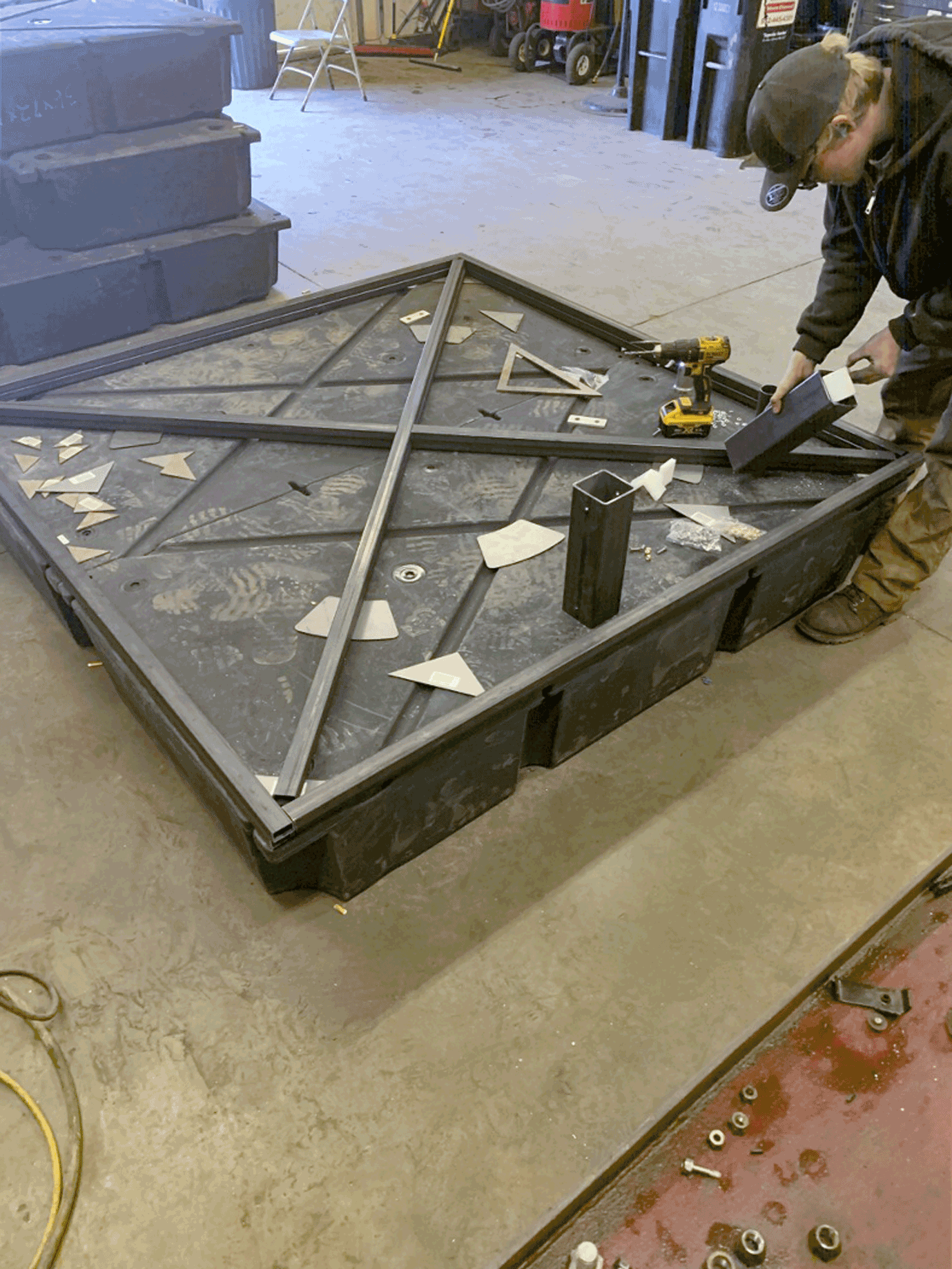
Construction of floating base and supports of bait delivery platform. Photograph by James Wamboldt, U.S. Geological Survey.
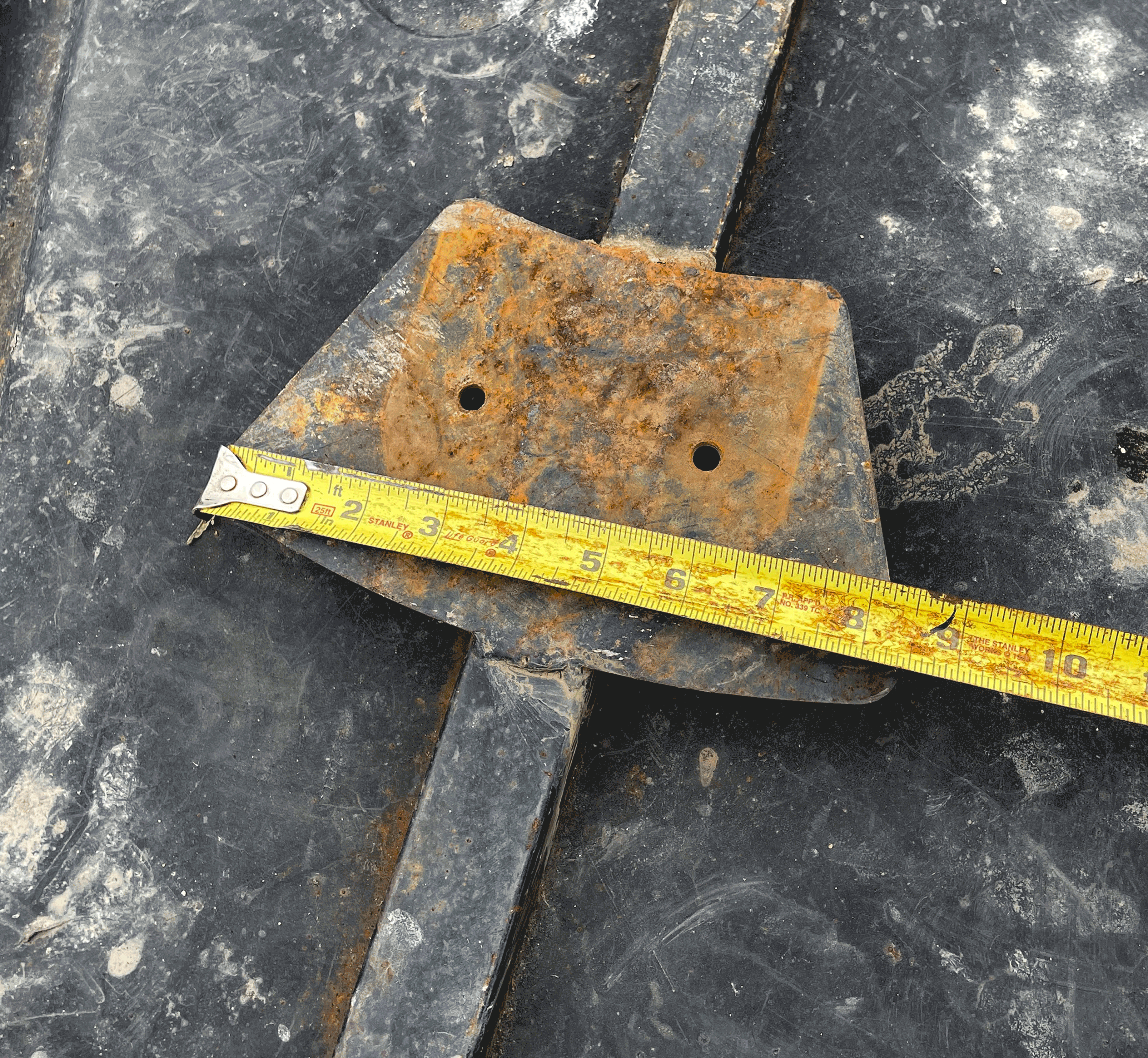
Metal support brackets used to secure automated feeder to the bait delivery platform. Photograph by James Wamboldt, U.S. Geological Survey.
Two support brackets (8.89 x 8.89 cm) with a wall thickness of 4.76 millimeters were welded to opposite corners of the platform to allow for anchor pole attachment (fig. 3). Because of a high center of mass, a single support pole and (or) anchors for securing bait platforms should be avoided. As designed, if two support poles are used to anchor it, the platform can safely support a full feeder and two personnel for filling and maintenance (fig. 4). Multiple anchor points also help ensure the feeder is deploying bait in the desired direction. It is recommended that hardware, fasteners, and pipe designed for floating docks not be used because this equipment cannot withstand the added stress bait platforms endure being left independent of other structures (for example, docks and shoreline), effects from debris, and fluctuating river conditions. Anchor poles need to be sturdy enough to withstand bending and tall enough to accommodate high water. Schedule 40 carbon structural American Society for Testing and Materials A500 grade B pipe (6.033-cm outside diameter x 0.391-cm width) was used in locations with potential for high river velocities. Metal or plastic pipe augers were attached to each pipe for easy installation and removal (fig. 5). It is important that pipes do not bend, have plenty of extra room to move within the support brackets, and are installed in a vertical position at the proper distance for the platform to adjust to fluctuating river conditions and to simplify platform removal (fig. 6).
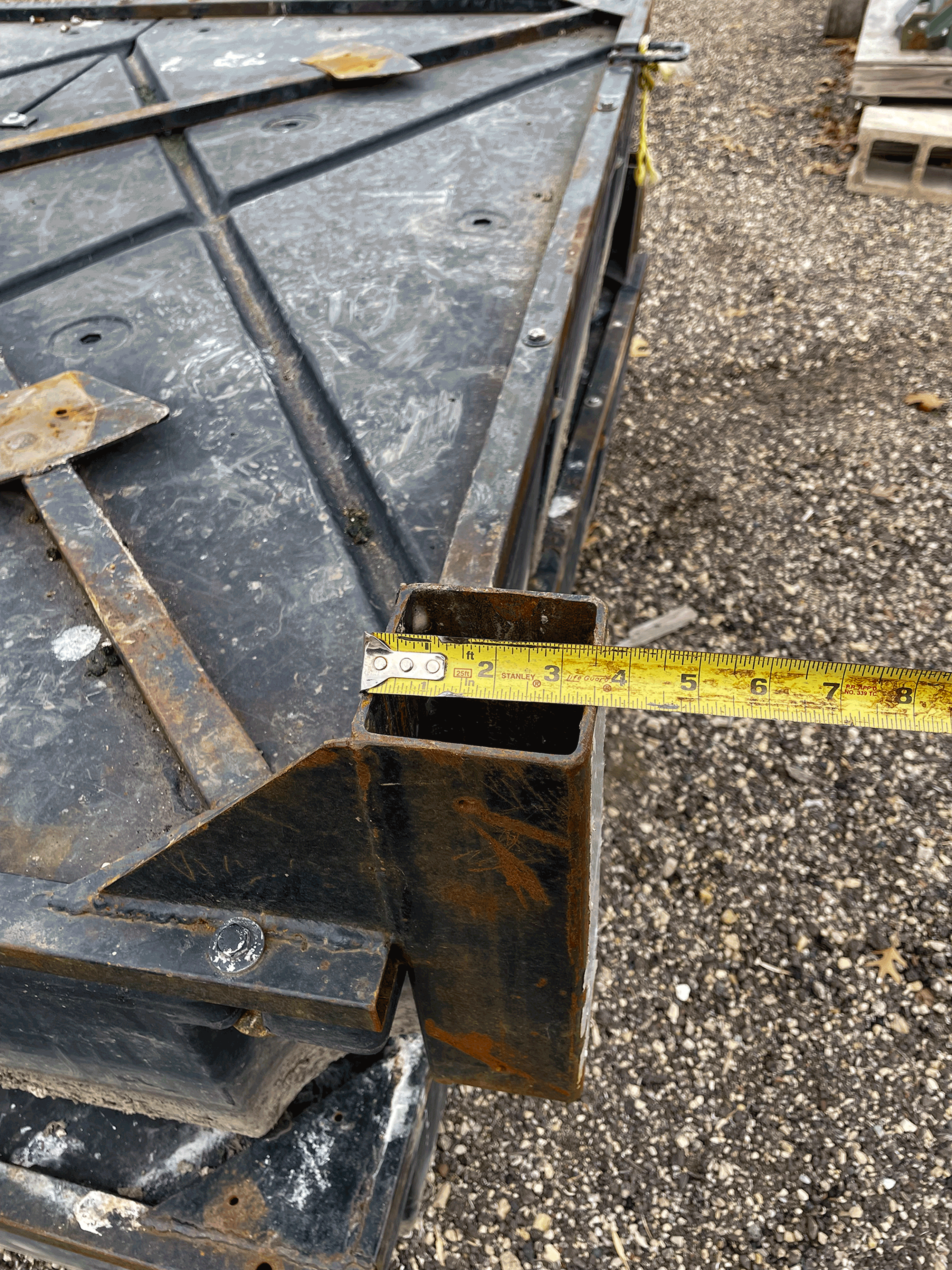
Support bracket used to secure bait delivery platform in place with support poles. Photograph by James Wamboldt, U.S. Geological Survey.
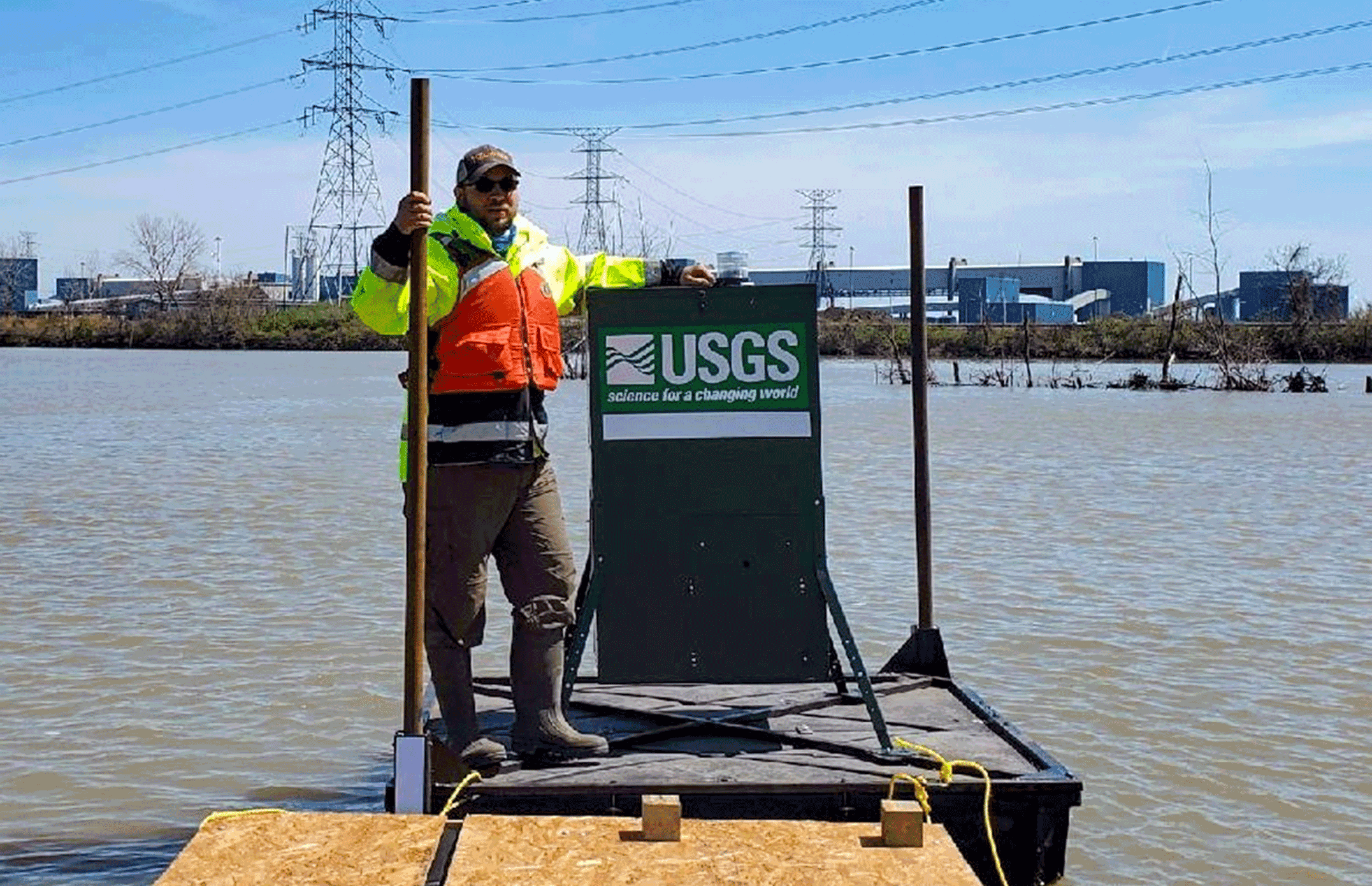
Completed and installed bait delivery platform in place at Plum Creek, Michigan. Photograph by Linnea Thomas, U.S. Geological Survey.
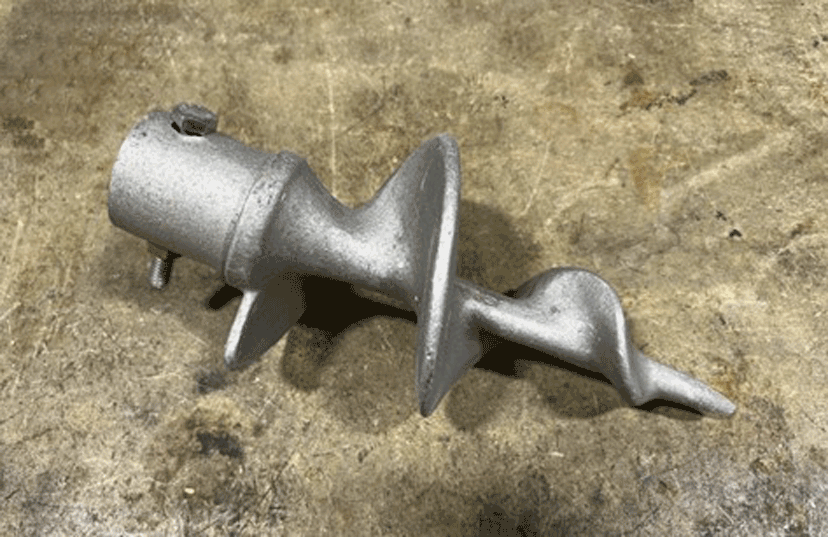
Aluminum dock auger for a 2-inch outside diameter pipe. Photograph by James Wamboldt, U.S. Geological Survey.
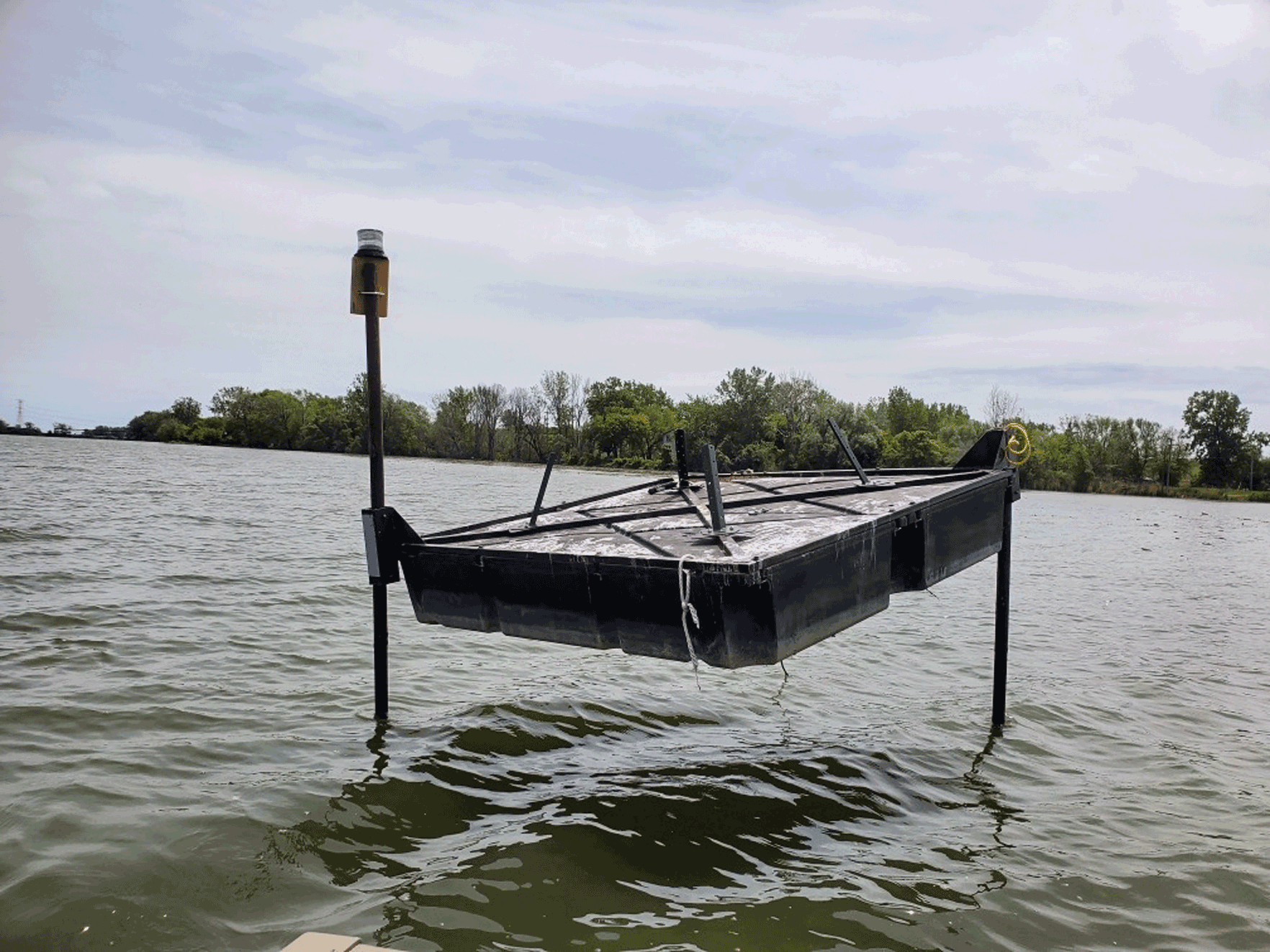
Improper installation of bait delivery platform in place at Plum Creek, Michigan. One anchor pole was not long enough to account for river fluctuation, and the poles were installed too far apart to allow easy vertical movement. Photograph by James Wamboldt, U.S. Geological Survey.
Different types of feeders can be attached to this platform if the frame and attachment plates are in accommodating positions. Directional feeders built for aquaculture ponds ensure bait is being deployed in the desired direction, but a nondirectional wildlife feeder can also be used. An aluminum plate (45.72 x 50.80 cm) was attached below the feeder opening to keep bait off the platform and in the water (fig. 7). Depending on pellet size and density of bait, the hopper capacity of the feeder used to deliver bait to grass carp in the Sandusky River, Ohio, from 2020 to 2022 was 193 kilograms. Manufacturer recommendations specify a bait pellet size less than or equal to 0.76 cm. Feeders are operated with a 12-volt sealed lead acid battery charged with a solar panel. A programmable control panel allows for as many as nine feeding events daily, each as many as 60 seconds long.
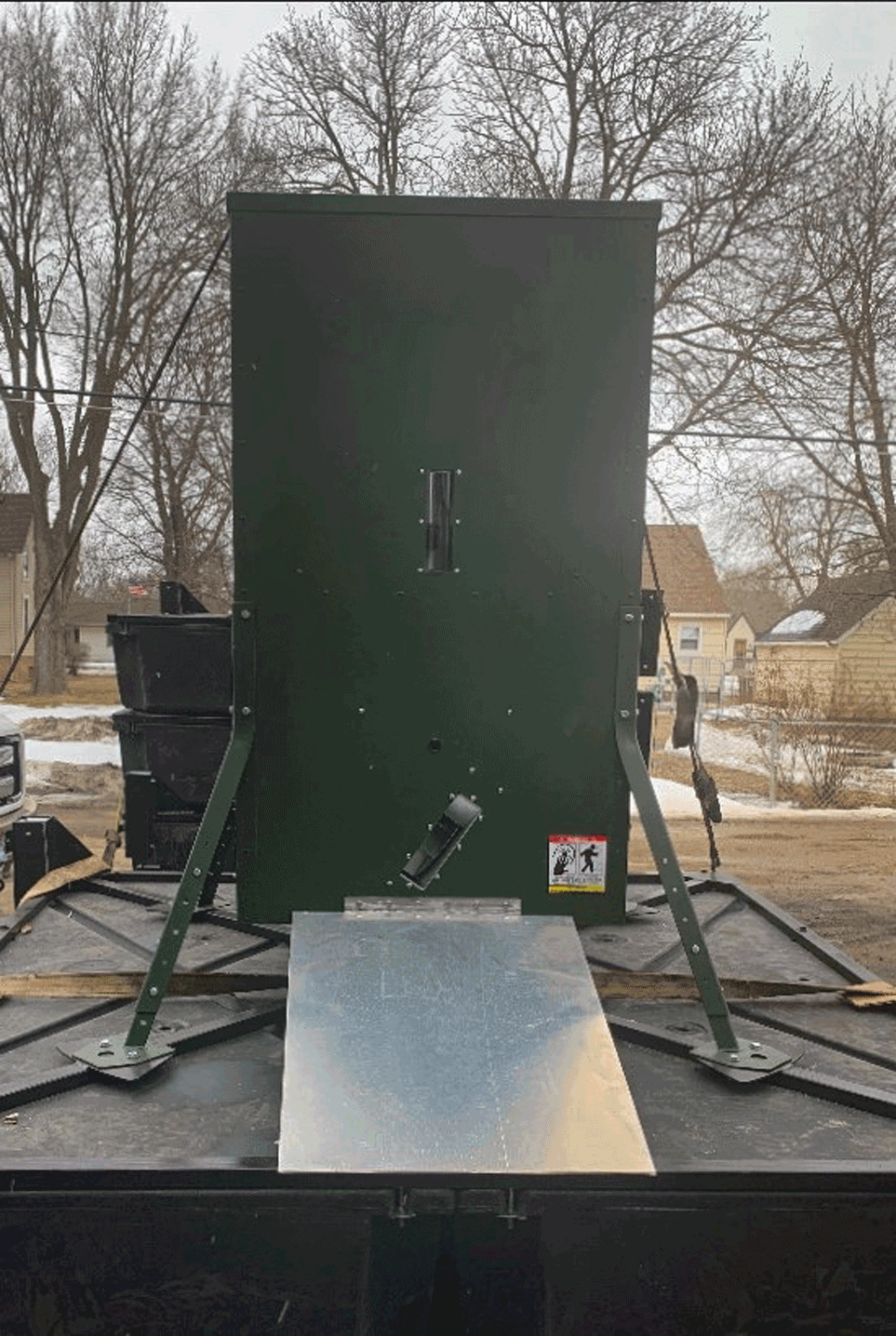
Aluminum plate attachment to keep bait debris off the platform base. Photograph by James Wamboldt, U.S. Geological Survey.
Safety Considerations
Visibility to watercraft operators is vital for the safe use and automatous operation of the bait delivery platform. Platforms must be visible during the day and night in clear and inclement weather. Depending on where a platform will be placed, it is important to contact local law enforcement, the U.S. Coast Guard, and the U.S. Army Corps of Engineers about required local visibility safety requirements. Safety design features described in this document were required for installation in the Sandusky River, Ohio, but may not encompass all requirements elsewhere. In addition to physical design features, placement of platforms within the river channel or lake can affect how safe the platform will be. It is recommended that a platform not be placed in conspicuous locations, such as a tight river bend or behind an island or high vegetation. If a platform will be installed close to the shoreline, it is important to understand that they can easily blend in with trees and vegetation behind the platform during daylight hours.
A solar powered marine light (white) must be attached to the top of each platform and be visible on all sides for as much as 1 mile at night. Reflective tape should be used on all sides of the platform and feeder. Using reflective tape and solar lights on the platform and feeder separately should be considered if the platform may be left out without the feeder for any time or theft is a concern. We also used orange safety flags and high-visibility tape to increase daytime visibility. Anchor pipes that are long enough to accommodate river flood stage and allow the platform to float off its support brackets under extreme conditions should be installed to protect the platform from being destroyed and to prevent debris in the river during high water conditions. As an additional layer of safety, a back-up anchor should be used to hold the platform in place if it comes off the anchor pipes in high water.
A job hazard analysis should be completed for each installation site to identify possible safety concerns. Hardhat usage is recommended when installing anchor pipes. Operational and safety procedures for working in the field should be followed by all personnel (Yobbi and others, 1996).
Deployment
If the installation location and environmental conditions allow, the feeder should be attached to the platform onshore for the simplest and safest method for deployment. Once attached, the feeder and platform can be towed to the location with a parallel alongside tow attachment towing approach. If feeders and platforms must be transported to the deployment location in a boat, the platform should be secured in place with anchor poles before the feeder is attached. The feeder should not be filled until the platform is secured in place with anchor poles. A dock post auger wrench can simplify anchor pole installation and removal and should be attached to the pole before inserting it through the support brackets to improve maneuverability and handling while the support pole is vertical. Once the pole is vertical, the auger wrench cannot be attached to the pole because of its height.
Equipment List
Between 2019 and 2021, the total cost for one platform ranged from $2,250 to $2,925. The equipment needed is as follows:
-
• 1 fish feeder (12-volt battery included),
-
• 1 solar charger,
-
• 2 dock floats (91.44 x 182.88 x 30.48 cm),
-
• 2 schedule 40 (6.033-cm outside diameter x 0.391-cm width) carbon structural American Society for Testing and Materials A500 grade B pipes (6.1 m),
-
• 1 welded steel frame,
-
• 2 post augers for docks,
-
• Dock post auger wrench, and
-
• Solar marine light.
References Cited
Bodine, K.A., Shoup, D.E., Olive, J., Ford, Z.L., Krogman, R., and Stubbs, T.J., 2013, Catfish sampling techniques—Where we are now and where we should go: Fisheries, v. 38, no. 12, p. 529–546. [Also available at https://doi.org/10.1080/03632415.2013.848343.]
Bonneau, J.L., and Scarnecchia, D.L., 2001, Tests of a rotenone-impregnated bait for controlling common carp: Journal of the Iowa Academy of Science, v. 108, no. 1, p. 6–7. [Also available at https://scholarworks.uni.edu/jias/vol108/iss1/4.]
Flammang, M.K., and Schultz, R.D., 2007, Evaluation of hoop-net size and bait selection for sampling channel catfish in Iowa impoundments: North American Journal of Fisheries Management, v. 27, no. 2, p. 512–518. [Also available at https://doi.org/10.1577/M05-151.1.]
Ghosal, R., Eichmiller, J.J., Witthuhn, B.A., and Sorensen, P.W., 2018, Attracting Common Carp to a bait site with food reveals strong positive relationships between fish density, feeding activity, environmental DNA, and sex pheromone release that could be used in invasive fish management: Ecology and Evolution, v. 8, no. 13, p. 6714–6727. [Also available at https://doi.org/10.1002/ece3.4169.]
Hundt, P.J., Amberg, J., Sauey, B., Vacura, K., and Bajer, P.G., 2020, Tests in a semi-natural environment suggest that bait and switch strategy could be used to control invasive Common Carp: Management of Biological Invasions, v. 11, no. 3, p. 428–440. [Also available at https://doi.org/10.3391/mbi.2020.11.3.06.]
Mallison, C.T., Hestand, R.S., III, and Thompson, B.Z., 1995, Removal of triploid grass carp with an oral rotenone bait in two central Florida lakes: Lake and Reservoir Management, v. 11, no. 4, p. 337–342. [Also available at https://doi.org/10.1080/07438149509354215.]
Neely, B.C., and Dumont, S.C., 2011, Effect of soak duration on precision of channel catfish catch with baited, tandem hoop nets: American Fisheries Society Symposium, v. 77, no. 1, p. 557–561. [Also available at https://doi.org/10.47886/9781934874257.ch46.]
Pierce, R.B., Coble, D.W., and Corley, S., 1981, Fish catches in baited and unbaited hoop nets in the Upper Mississippi River: North American Journal of Fisheries Management, v. 1, no. 2, p. 204–206. [Also available at https://doi.org/10.1577/1548-8659(1981)1%3C204:FCIBAU%3E2.0.CO;2.]
Poole, J.R., Sauey, B.W., Amberg, J.J., and Bajer, P.G., 2018, Assessing the efficacy of corn-based bait containing antimycin-a to control common carp populations using laboratory and pond experiments: Biological Invasions, v. 20, no. 1, p. 1809–1820. [Also available at https://doi.org/10.1007/s10530-018-1662-y.]
Yobbi, D.K., Yorke, T.H., and Mycyk, R.T., 1996, A guide to safe field operations: U.S. Geological Survey Open-File Report, 95–777. [Also available at https://doi.org/10.3133/ofr95777.]
For more information about this publication, contact:
Director, USGS Upper Midwest Environmental Sciences Center
2630 Fanta Reed Road
La Crosse, Wisconsin 54603
608–783–6451
For additional information, visit: https://www.usgs.gov/centers/umesc
Publishing support provided by the
Rolla Publishing Service Center
Disclaimers
Any use of trade, firm, or product names is for descriptive purposes only and does not imply endorsement by the U.S. Government.
Although this information product, for the most part, is in the public domain, it also may contain copyrighted materials as noted in the text. Permission to reproduce copyrighted items must be secured from the copyright owner.
Suggested Citation
Wamboldt, J.J., 2023, Design and utility of automatous, floating bait delivery platform for applying fish management baits: U.S. Geological Survey Techniques and Methods, book 8, chap. D2, 8 p., https://doi.org/10.3133/tm8D2.
ISSN: 2328-7055 (online)
| Publication type | Report |
|---|---|
| Publication Subtype | USGS Numbered Series |
| Title | Design and utility of automatous, floating bait delivery platform for applying fish management baits |
| Series title | Techniques and Methods |
| Series number | 8-D2 |
| DOI | 10.3133/tm8D2 |
| Publication Date | September 12, 2023 |
| Year Published | 2023 |
| Language | English |
| Publisher | U.S. Geological Survey |
| Publisher location | Reston, VA |
| Contributing office(s) | Upper Midwest Environmental Sciences Center |
| Description | vi, 8 p. |
| Online Only (Y/N) | Y |
| Additional Online Files (Y/N) | N |


